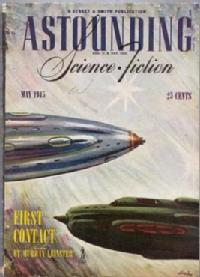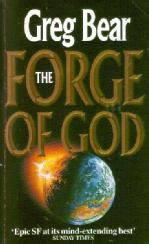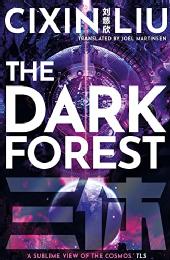The Dark Forest
As we’ve discussed before, one solution to the Fermi Paradox is the idea that alien races have chosen caution and declined to announce their existence, rather than focussing on exploration and engagement. Here we consider that idea – sometimes known as the Dark Forest paradigm – and its place in science fiction in more detail.
The Fermi paradox can be encapsulated in a very simple question: if alien races are as abundant in our galaxy as we believe suitable planets to be, why have we not encountered any of them already? Prominent scientists, including physicist Stephen Hawking in 2010 [1], have suggested that we might take this as a hint and a warning. Given the timescales for evolution, and the number of sun-like stars in the Milky Way, if intelligent life has arisen more than once, it must have arisen many times, and many of the races thus generated must be significantly more advanced than humanity.
However the long history of colonialism on Earth has suggested that less technologically-developed races invariably end up poorer, socially disrupted and in a subordinate position when encountering those with more technology. More than that, the potentially massive technical imbalances result in a Game Theory analysis which strongly favours a first-strike policy. If there’s any chance at all that an alien race might destroy humanity, then preemptively destroying any aliens we encounter is our only chance of survival. If the Galaxy is indeed full of advanced life then, the sensible approach for humanity would be to remain silent and avoid contact. What’s more, every other alien race reaching this stage of development would be likely to have undertaken the same analysis and reached the same conclusions. Even normally peaceful sentient species may feel they have no choice but to make a first strike if alien life is encountered. As a result, Hawking and others have criticised the METI (Messaging Extraterrestrial Intelligence) concept as unwise, and suggested that SETI (the Search for Extraterrestrial Intelligence) may be pointless.
 However modern scientists and mathematicians are by no means the first to consider this possibility. Published in Astounding Science Fiction magazine in 1945, Murray Leinster’s novelette “First Contact” describes a first encounter between humans and another spacefaring species – indeed this story coined the term First Contact, now widely used to refer to a species' introduction to alien life. The human ship is on a scientific mission to the Crab Nebula, studying its evolution and that of its binary white-dwarf central star [2] by taking a series of images as they approached (each of light emitted progressively later in the evolution of the supernova remnant than the one before). However their scans reveal the first alien spaceship ever encountered. The crews of the two space vessels establish communication and, over time, even friendly relations over the radio. However neither can take the chance of the other following them back to their home world with hostile intent – indeed, for both species mutual annihilation is deemed a better outcome than risking the security of Earth, or the alien homeworld.
However modern scientists and mathematicians are by no means the first to consider this possibility. Published in Astounding Science Fiction magazine in 1945, Murray Leinster’s novelette “First Contact” describes a first encounter between humans and another spacefaring species – indeed this story coined the term First Contact, now widely used to refer to a species' introduction to alien life. The human ship is on a scientific mission to the Crab Nebula, studying its evolution and that of its binary white-dwarf central star [2] by taking a series of images as they approached (each of light emitted progressively later in the evolution of the supernova remnant than the one before). However their scans reveal the first alien spaceship ever encountered. The crews of the two space vessels establish communication and, over time, even friendly relations over the radio. However neither can take the chance of the other following them back to their home world with hostile intent – indeed, for both species mutual annihilation is deemed a better outcome than risking the security of Earth, or the alien homeworld.
The story provides a tense insight into the balance between the urge to explore and communicate, and the genuine risk that entails. The story was adapted at least three times for radio broadcast in the 1950s (as part of NBC anthology series Dimension-X and X-Minus-One which used the same script, and in MBCs Exploring Tomorrow) and the ending of the NBC adaptation is rather less optimistic than that of the novelette – perhaps reflecting increasing paranoia regarding other cultures as the Cold War matured.
 Greg Bear’s 1987 novel The Forge of God applies this paranoid premise explicitly to the concept of METI, or even the accidental spilling of radio signals from Earth into space. Rather than dealing with the mutual threat of two equally matched spacecraft in a first contact scenario, Bear's narrative discusses the threat that our entire civilisation faces in the face of an overwhelming alien force, comparing Earth’s naive broadcasts to a baby’s cries attracting wolves in a woodland and noting that
Greg Bear’s 1987 novel The Forge of God applies this paranoid premise explicitly to the concept of METI, or even the accidental spilling of radio signals from Earth into space. Rather than dealing with the mutual threat of two equally matched spacecraft in a first contact scenario, Bear's narrative discusses the threat that our entire civilisation faces in the face of an overwhelming alien force, comparing Earth’s naive broadcasts to a baby’s cries attracting wolves in a woodland and noting that
"We've been sitting in our tree chirping like foolish birds for over a century now, wondering why no other birds answered. The galactic skies are full of hawks, that's why." (The Forge of God, Legend edition, 1989, pg 315).
In this context, the Dark Forest model of the Universe is an extension of the older Berserker explanation of the Fermi paradox: the idea that one or more alien species is actively hunting out any sentient life that might challenge it, leaving a network of self-replicating (von Neumann) probes to detect and destroy nascent interstellar species. This formed the major theme of Fred Saberhagan’s Berserker series (novels, 1967 onwards, which named the genre) and also of Alistair Reynolds’ Redemption Ark series (novels, 2002 onward, which imagined “Inhibitors” left behind by ancient civilisations to prevent resource depletion). Where the Berserker premise as seen in The Forge of God differs is that it imagines the presence of Berserker/Inhibitors as coming as a surprise to naively-enthusiastic life forms. The Dark Forest hypothesis itself, however, is an altogether more cynical scenario, where, rather than outward-looking species in a generally open galaxy falling prey to a single hostile actor, even the prospect of such threats keeps humanity - and the rest of sentient life in the Galaxy - cowering timidly in the dark.
This paranoid premise has been hinted at in a lot of science fiction. For example Gregory Benford and Larry Niven had an alien species voice the concept in Shipstar (2014):
“Most keep silent, their radiated power low, fearing unknown perils. We often found such silent planets. We were drawn to worlds we knew by distant examinations were life-bearing, yet electromagnetically quiet.”
 However, most famously, this theory was further described and given a name in The Dark Forest (2007, trans. 2015), the second novel in Chinese author Cixin Liu’s Three Body Problem trilogy. In the first novel, a human-sent signal is detected by an alien species in an unstable, dying solar system. The second novel describes humanity’s response to a threatened invasion by these Trisolarian aliens - an existential danger that can all be traced back to that one naive METI effort. However, as becomes clear, this is a threat that can as easily apply to the Trisolarians as the humans of Earth. As Liu describes it:
However, most famously, this theory was further described and given a name in The Dark Forest (2007, trans. 2015), the second novel in Chinese author Cixin Liu’s Three Body Problem trilogy. In the first novel, a human-sent signal is detected by an alien species in an unstable, dying solar system. The second novel describes humanity’s response to a threatened invasion by these Trisolarian aliens - an existential danger that can all be traced back to that one naive METI effort. However, as becomes clear, this is a threat that can as easily apply to the Trisolarians as the humans of Earth. As Liu describes it:
“The universe is a dark forest. Every civilization is an armed hunter stalking through the trees like a ghost, gently pushing aside branches that block the path and trying to tread without sound. Even breathing is done with care. The hunter has to be careful, because everywhere in the forest are stealthy hunters like him. If he finds other life—another hunter, an angel or a demon, a delicate infant or a tottering old man, a fairy or a demigod—there’s only one thing he can do: open fire and eliminate them. In this forest, hell is other people. An eternal threat that any life that exposes its own existence will be swiftly wiped out. This is the picture of cosmic civilization. It’s the explanation for the Fermi Paradox.”
The Dark Forest concept was revisited by dramatist Katherine Soper in a play for BBC Radio Four, Calls from Far Away (2022, available to listen to here). In this story, a freelance journalist is visiting ESA headquarters when a rover probe discovers extraterrestrial message plaques embedded in the ice of Pluto. Over the following ten years, she weighs the change in world view that results from the revelation of alien life, against the day-to-day reality of climate change and other social changes as experienced by her son. Both 2001: A Space Odyssey and the Dark Forest theory are explicitly invoked, the latter to explain why the Messengers have never been heard from again after leaving their plaques – if they made their presence known, they might have paid the price. In Soper’s drama, this possible interpretation is introduced by a character who wishes the journalist to focus more on her own world’s troubles, but it also reflects a shift towards pessimism in humanity’s worldview. By floating a reason that humanity should reject the stars, he is urging a refocus on the one fully habitable world of which we are certain: the Earth itself.
While valuing the resource-rich planet we have is clearly important, should we really be hiding from a maybe-hostile universe? Should we be taking the risk inherent in METI, and should we be surprised when SETI fails?
Of course it remains possible that alien mindsets differ substantially from our own. Perhaps no other race is so cynical about the intentions of others, or wedded to game theory analysis of the potential threat. Perhaps no other species is quite so aggressive as we imagine. In Doctor Who’s "The Christmas Invasion" (2005), the Doctor bitterly commented that he gave a since-destroyed invading spacecraft the wrong warning. Rather than telling them to spread the world that Earth was protected, he muses, he should have said “run, the humans are coming!”. Perhaps, he was right and we are unusually militaristic in our approach to self-protection. Maybe letting the Dark Forest threat determine our actions would mean isolating ourselves in the Universe for no good reason. It’s hard to argue, however, that the potential benefits of ignoring the threat can outweigh the potential damage that might result if the threat is real.
Maybe there’s no one hiding behind the next tree at all. But in a dark forest, how could we ever know?
“The Dark Forest”, Elizabeth Stanway, Cosmic Stories blog, 3rd June 2023.
Notes:
[1] Despite this warning, Professor Stephen Hawking was an active advocate for human spaceflight and for SETI programmes to listen to aliens - he just warned that advertising our presence was perhaps an unwise idea. [Return to text]
[2] Leinster’s story is also notable for a reasonably good scientific discussion of SN 1054, which formed the Crab Nebula, of white dwarfs, and of the differences between life around the Sun and life around a red dwarf star. [Return to text]
All thoughts and opinions expressed here are the author's own and do not necessarily reflect those of the University of Warwick. Images used here are sourced from public sources online.
